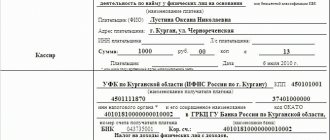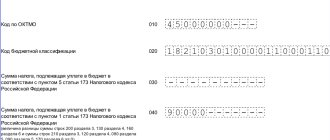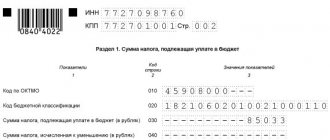Payers of this tax must submit a declaration on mineral extraction tax.
Draw up the declaration in the form approved by order of the Federal Tax Service of Russia dated May 14, 2015 No. ММВ-7-3/197. The same order approved the Procedure for filling out and electronic format for submitting a tax return.
Situation: is it necessary to file mineral extraction tax declarations if an organization has suspended the use of a subsoil plot?
Yes need.
If an organization is recognized as a payer of mineral extraction tax, declarations must be submitted starting from the month in which actual mining began (clause 1 of Article 345 of the Tax Code of the Russian Federation). Until this point, the organization is not required to submit declarations. However, the legislation does not provide for such an exemption if the organization has suspended the use of a subsoil plot. Therefore, if an organization began actual mining of mineral resources at a subsoil site, but then suspended it, continue to submit declarations.
This procedure is confirmed by letters of the Ministry of Finance of Russia dated November 22, 2011 No. 03-06-05-01/117 and the Federal Tax Service of Russia dated December 19, 2011 No. ED-4-3/21564.
New report form
The Federal Tax Service of Russia, by order dated December 8, 2020 No. KCh-7-3/ [email protected], updated the form and procedure for reporting on mineral extraction tax. The amendments were required in connection with significant changes to the Tax Code on mineral extraction tax, which entered into force on 01/01/2021. A new form of the mineral extraction tax declaration has been approved, taking into account the regional coefficient, the rules for filling it out and the electronic format for submission.
Among the significant changes:
- A new procedure for transferring mineral extraction tax to the budget and determining the tax base for natural diamonds weighing more than 10.80 carats. The tax base for such stones is determined based on their sales prices excluding VAT, but not lower than their initial assessment.
- If the status of a participant in a regional investment project is terminated by a court decision, the taxpayer loses the right to apply a coefficient Ktd less than 1 from the tax period in which it was first applied.
- The value of mined precious stones is assessed on the basis of the taxpayer’s weighted average sales price in the tax period excluding VAT, but not lower than their initial assessment carried out in accordance with the legislation on precious metals and precious stones. If there are no sales in the tax period, the data of the nearest 12 previous months are taken into account.
IMPORTANT!
The order came into force two months after publication - 03/15/2021. The declaration in the new form must be submitted for the tax period following the month the document entered into force - April 2021. Therefore, for January-March 2021 it is necessary to report on the previous declaration form. The deadline for submitting the mineral extraction tax for March 2021 is until 04/30/2021.
Section 2
Section 2 of the declaration is filled out by the taxpayer separately for oil extracted from each subsoil plot provided to the taxpayer for use.
Section 2 is filled out separately for the BSC and separately for each type of extracted mineral.
On line 010 the code of the type of mineral extracted corresponding to oil is indicated - 03100
Line 020 indicates the BCC, in accordance with which the tax is paid in respect of this extracted mineral.
Line 030 indicates the code of the unit of measurement of the amount of extracted minerals according to the All-Russian Classifier of Units of Measurement OK 015-94.
Subsection 2.1 indicates the indicators of the amount of oil produced for all subsoil areas where the company produces:
- line 040 – OKTMO code;
- line 050 – series, number and type of license for the use of subsoil (for example: STV 12345 NE);
- on line 060 - the value of the indicator characterizing the characteristics of oil production (Dm), for oil extracted from deposits for which the value of the coefficient characterizing the degree of complexity of oil production (Kd) is equal to 1. The indicator Dm is determined accurate to the second decimal place;
- on line 070 - Kndpi indicator;
- on line 080 - coefficient characterizing the dynamics of world oil prices (Kts). It is rounded to the fourth decimal place;
- on line 090 - a coefficient characterizing the degree of depletion of reserves of a subsoil site (Kv). Its value is also rounded to the fourth decimal place;
- on line 100 - the degree of depletion of reserves of the subsoil site (Sv) accurate to the fourth decimal place;
- on line 110 - a coefficient characterizing the amount of reserves of a particular subsoil area (Kz), also accurate to the fourth decimal place;
- on line 115 - the value of the coefficient characterizing the degree of depletion of a specific hydrocarbon deposit (Kdv);
- on line 120 - the value of the coefficient characterizing the region of production and the properties of oil (Kkan);
- on line 130 - the amount of tax calculated for oil production at the subsoil site. It depends on the indicator in column 1 of subsection 2.1.1. If the code “2000” is indicated in it, then:
| tax amount | = | (tax rate X line 080 of subsection 2.1 – line 060 of subsection 2.1) | X | column 2 of subsection 2.1.1 | X | 0,7 |
If the code “4000” is indicated in column 1 of subsection 2.1.1, then:
| tax amount | = | (tax rate X line 080 of subsection 2.1 – line 060 of subsection 2.1) | X | column 2 of subsection 2.1.1 |
The resulting tax amount must be added to the indicator of line 270 of all subsections 2.1.2 for all deposits related to the subsoil plot, the details of the license for the right to use which are indicated in line 050 of subsection 2.1. The result will be reflected on line 130;
- Line 140 indicates the amount of tax deduction to be applied in the manner established by Article 343.2 of the Tax Code. If there is no tax deduction amount, zero is entered on line 140;
- line 150 indicates the amount of tax payable to the budget for the extracted minerals, determined by the formula:
| Line 150 | = | Line 130 | — | Line 140 |
Subsection 2.1.1 contains data on the amount of oil produced at the subsoil site, the details of the license for the right to use which are indicated in line 050 of subsection 2.1, for which the value of the coefficient Kd is 1
In column 1, the code for the basis for taxation of mineral resources is entered, in accordance with Appendix 3 to the Procedure for filling out the declaration.
Column 2 indicates the amount of oil produced, subject to taxation at the tax rate corresponding to the code entered in column 1. It is determined accurate to the third decimal place. This does not reflect the amount of oil produced from the reservoir:
— for which the value of the coefficient Kd < 1,
- classified as Bazhenov, Abalak, Khadum or Domanik productive deposits, subject to the conditions provided for in subparagraph 21 of paragraph 1 of Article 342 of the Code,
— containing oil with a viscosity of more than 200 mPa x s and less than 10,000 mPa x s (in reservoir conditions).
Data on the amount of such oil are reflected in subsection 2.1.2 of the declaration.
In it, line 160 indicates the name of the hydrocarbon deposit. Line 170 indicates the effective oil-saturated thickness of the formation in meters. The sources of such information are the same as for line 160. Line 170 is filled in if Kd coefficient values of 0.4 or 0.8 are used. In other cases, a dash is placed here.
Line 180 reflects the permeability indicator of the hydrocarbon reservoir in µm2 if Kd coefficient values of 0.4 or 0.8 are used. In other cases, a dash is placed here. The sources of information for completing this line are the same as for lines 160 and 170.
Line 190 indicates the depth of the productive hydrocarbon deposit in meters. If the state balance of mineral reserves reflects the range of depth of the productive formation, then line 190 indicates the minimum value.
Line 200 displays the oil density in g/cm3. If it is set as a range, then its minimum value is reflected here.
Line 210 indicates the value of the indicator characterizing the characteristics of oil production (Dm) for oil extracted from a deposit for which the value of the coefficient Kd < 1 and the value of the coefficient Kdv 1, as well as for oil with a viscosity of more than 200 mPa x s and less than 10,000 mPa x с (in reservoir conditions), for which the value of the coefficient Kcan is zero. The Dm indicator is determined accurate to the second decimal place. When extracting oil from a deposit classified as the Bazhenov, Abalak, Khadum or Domanik productive deposits, a dash is placed on line 210.
Line 220 indicates the degree of depletion of reserves of a particular hydrocarbon deposit accurate to the fourth decimal place.
Lines 160-200, 220 are filled out in accordance with the data of the state balance of mineral reserves, approved in the year preceding the year of the tax period, or according to the conclusion of the state examination of mineral reserves.
Line 230 indicates the value of the coefficient characterizing the degree of difficulty of oil production (Kd).
Line 240 indicates the number of tax periods when the coefficient Kd < 1 is applied.
Line 250 reflects the value of the coefficient characterizing the degree of depletion of a specific hydrocarbon deposit (Kdv) accurate to the fourth decimal place.
When filling out subsection 2.1.2 for deposits for which the coefficient Kd = 1, a dash is placed on lines 240-250.
Line 260 indicates the number of tax periods for applying the mineral extraction tax rate of 0 rubles. When extracting oil from deposits that do not belong to the Bazhenov, Abalak, Khadum or Domanik productive deposits, a dash is placed on line 260.
Line 270 indicates the amount of calculated tax on oil extracted from the deposit.
The amount for the specified line is determined depending on what code is indicated in column 1 of subsection 2.1.2:
If the code “2000” is specified, then:
| tax amount | = | (tax rate X line 080 of subsection 2.1 – line 210 of subsection 2.1.2) | X | column 2 of subsection 2.1.2 | X | 0,7 |
If the code “4000” is indicated in column 1 of subsection 2.1.2, then:
| tax amount | = | (tax rate X line 080 of subsection 2.1 – line 210 of subsection 2.1.2) | X | column 2 of subsection 2.1.2 |
Then, in column 1, the code for the basis for taxation of extracted minerals is entered, in accordance with Appendix 3 to the Procedure for filling out the declaration.
Column 2 indicates the amount of oil extracted from the hydrocarbon deposit, subject to taxation at the tax rate corresponding to the tax basis code entered in column 1.
The amount of minerals extracted is determined accurate to the third decimal place.
Who is obliged to take
Mineral miners and subsoil users are required to report on their mining activities. The category of accountable persons includes all payers of this tax: both organizations and individual entrepreneurs. Such taxpayers require a license allowing the use of subsoil.
The Tax Code of the Russian Federation specifies when a subsoil report is submitted - from the moment of registration as a mineral miner and after receiving a license, monthly reporting must be generated (Chapter 26 of the Tax Code of the Russian Federation). Until registration as a MET taxpayer, a report is not submitted.
IMPORTANT!
If the use of subsoil is temporarily suspended, you will still have to report production tax (letter of the Federal Tax Service No. SD-4-3 / [email protected] dated 08/21/2020). Here's how to confirm the legality of submitting a zero primary declaration for mineral extraction tax - write to the Federal Tax Service a covering letter stating that the use of subsoil has been temporarily suspended, and attach supporting documents (orders, acts, etc.) to it.
Title page
On the title page please indicate:
- TIN (if the TIN is 10 digits, then in the first two cells of the line reserved for the TIN, zeros (“00”) should be entered);
- Checkpoint (indicate the checkpoint assigned to the organization by the inspectorate at the place of filing the declaration).
If an organization provides a declaration at the location of the organization, then use the TIN and KPP values from the certificate of registration in Form No. 1-1-Accounting (the largest taxpayers - from the notification in Form No. 9-KNU, foreign organizations - from the certificate in Form No. 11SV -Accounting;
- adjustment number (when preparing the initial declaration, indicate “0—”, when submitting an updated declaration, indicate the serial number of the adjustment – “1—”, “2—”, “3—”);
- code of the tax period for which the declaration is submitted, in accordance with Appendix 1 to the Procedure approved by Order of the Federal Tax Service of Russia dated May 14, 2015 No. ММВ-7-3/197;
- code of the tax office to which the declaration is submitted;
- full name of the organization in accordance with the constituent documents, including its Latin transcription (if available);
- code of the type of economic activity according to the OKVED classifier;
- code of the form of reorganization (liquidation) in accordance with Appendix 1 to the Procedure, approved by order of the Federal Tax Service of Russia dated May 14, 2015 No. ММВ-7-3/197, as well as the TIN and KPP of the reorganized organization;
- contact phone number of the organization;
- the number of pages on which the declaration is drawn up;
- number of sheets of supporting documents or their copies.
The title page must contain the date the reporting was completed, as well as the seal of the organization and the signature of the person certifying the accuracy and completeness of the information specified in the declaration. If the accuracy and completeness of the information is confirmed by a representative of the organization, then attach a power of attorney confirming his authority to the declaration.
This procedure is provided for in clause 2.6 and section III of the Procedure, approved by order of the Federal Tax Service of Russia dated May 14, 2015 No. ММВ-7-3/197.
Due dates
All subsoil users have a single deadline for submitting declarations for subsoil use - monthly, on the last day of the month following the reporting period. That is, submit the declaration for January by February 28 (in 2021 - by March 1), the report for February - by March 31, and so on until the end of the year. If the last day of the month falls on a non-working day, the deadline is transferred to the first working day.
| Reporting period | Deadline for submitting the mineral extraction tax declaration in 2021 |
| For December 2020 | February 1 (01/31 - Sunday) |
| For January 2021 | March 1 (28.02 - Sunday) |
| For February | March 31 |
| For March | April 30 |
| For April | May 31 |
| For May | 30 June |
| For June | August 2 (July 31 - Saturday) |
| For July | August 31 |
| For August | September 30th |
| For September | November 1 (October 31 - Sunday) |
| For October | November 30th |
| For November | January 10, 2022 (December 31, 2021 is a non-working day) |
| For December 2021 | January 31, 2022 |
Where to take it
Taxpayers submit a declaration on the use of subsoil to the territorial offices of the tax inspectorate. Here's where to submit your subsoil report:
- for institutions that are large taxpayers (code 213 on the title page) - to the interdistrict tax office;
- for other taxpayers (code 214 on the title page) - to the Federal Tax Service at the place of registration;
- for foreign enterprises operating through Russian representative offices - at the place of operation.
The Federal Tax Service regulations explain whether it is necessary to submit a tax return on the mineral extraction tax if an organization has entered into a production sharing agreement; the participants in such an agreement do not have the opportunity to submit a tax return on the mineral extraction tax.
Composition of the declaration
The mineral extraction tax declaration includes:
- title page;
- Section 1 “Amount of tax to be paid to the budget”;
- Section 2 “Data serving as the basis for the calculation and payment of tax for the production of dehydrated, desalted and stabilized oil, with the exception of production at a new offshore hydrocarbon field”;
- Section 3 “Data serving as the basis for the calculation and payment of tax for the production of combustible natural gas and gas condensate, with the exception of production at a new offshore hydrocarbon field”;
- Section 4 “Data serving as the basis for the calculation and payment of tax when extracting hydrocarbons from a new offshore hydrocarbon field”;
- Section 5 “Data serving as the basis for the calculation and payment of tax, with the exception of hydrocarbons (except associated gas) and coal”;
- Section 6 “Determination of the cost of a unit of extracted mineral resources based on the estimated cost”;
- Section 7 “Data serving as the basis for the calculation and payment of tax when mining coal on a subsoil site.”
How to take it
As with any other report to the Federal Tax Service, the declaration on mining has two options for submission: on paper or electronically. The method of provision depends on the number of employees. If the institution employs up to 100 people, the report is submitted at the request of the taxpayer. This is a personal application to the Federal Tax Service or transfer of the register via telecommunication channels.
If a mining organization employs more than 100 people, it has no choice. The only available form of delivery is electronic.
How to fill
Mining reports include a title page and eight sections. Each paragraph corresponds to a separate type of extracted resource, therefore, the filling rules for each mineral are different. When entering information into report sections, follow a number of uniform rules. Here are general instructions on how to fill out a mineral extraction tax declaration for the extraction of sand or other minerals (a form that is valid until April 2021):
- The report is completed for each period (month) separately. Factual information is provided for each month, rather than cumulative information.
- The declaration must only fill out sections with those minerals to which the enterprise is directly related to the extraction. If the taxpayer produces oil, then he generates information under section 2, if oil and gas, then the information is submitted under sections 2 and 3 of the mineral extraction tax. The remaining chapters are not completed.
- The report is provided only for minerals for which the production cycle has been completed. If a resource is under development, it is not reflected in the report.
- In each declaration, the title page and section 1, which accumulates data on mineral extraction tax, must be completed.
- Fill out all digital values and cost indicators according to the rules of the Federal Tax Service. Each cell contains separate information.
- All pages used are numbered in order. Leaving the field is unacceptable.
- Do not use correction fluid or correct errors manually.
When filling out the content of the mineral extraction tax, you must use the rules set out in Appendix No. 2 to Order No. MMV-7-3/827 and letters of the Federal Tax Service of Russia No. SD-4-3 / [ email protected] , SD-4-3 / [email protected] from 04/18/2019.
Section 3
Section 3 is intended for data that serves as the basis for the calculation and payment of tax in the production of combustible natural gas and gas condensate, with the exception of production at a new offshore hydrocarbon field. It is filled out separately for the BSC and separately for each type of mineral extracted.
Line 010 indicates the type code of the extracted mineral “03200” (gas condensate) or “03300” (combustible natural gas).
Line 020 indicates the BCC, in accordance with which the tax is paid in respect of this extracted mineral.
Line 030 indicates the code of the unit of measurement of the amount of extracted minerals according to the All-Russian Classifier of Units of Measurement OK 015-94 (OKEY):
| Code | Unit name | Symbol | |
| national | international | ||
| Volume units | |||
| 112 | Liter; cubic decimeter | l; dm3 | I; L; 3 |
| 113 | Cubic meter | m3 | m3 |
| 118 | Deciliter | dl | dl |
| Units of mass | |||
| 163 | Gram | G | g |
| 166 | Kilogram | kg | kg |
| 168 | Ton; metric ton (1000 kg) | T | t |
Line 040 indicates the amount of calculated tax on the extracted minerals. It is defined as the sum of the values of line 190 of all subsections 3.1.1 for all deposits related to the subsoil area, the details of the license for the right to use which are indicated in line 090 of subsection 3.1.
Line 050 indicates the value of the indicator characterizing the cost of transporting combustible natural gas (Tg). If the Tg indicator has a negative value, then in line 050 it is indicated with a minus sign. When filling out Section 3 for gas condensate, a dash is placed on line 050.
Line 060 indicates the coefficient characterizing the share of gas sales to Russian consumers in the total volume of gas (G) sold by the organization.
Line 070 indicates the coefficient characterizing the share of produced combustible natural gas (except for associated gas) in the total volume of produced hydrocarbons (Kgpn).
In subsection 3.1
you need to indicate the indicators (coefficients) used to calculate the tax on the subsoil plot. In this case, the amount of extracted mineral resources is reflected separately for each license for the right to use subsoil.
Line 080 indicates the OKTMO code on the territory of which tax is paid for this type of extracted mineral.
Line 090 reflects the series, number and type of license for the use of subsoil.
On line 100, the value of the degree of depletion of natural combustible gas reserves of a specific subsoil area (SVg) is indicated, accurate to the fourth decimal place.
Line 110 indicates the base value of the standard fuel unit (Eut) accurate to the fourth decimal place.
Line 120 indicates the value of the correction factor (Kkm). When filling out Section 3 on natural gas, a dash is placed on line 120.
Line 130 indicates the coefficient characterizing the share of produced natural combustible gas (except for associated gas) in the total amount of natural combustible gas (except for associated gas) and gas condensate produced in the expired tax period on a subsoil plot containing a hydrocarbon deposit (Dg) . Its value is determined to the fourth decimal place.
Subsection 3.1.1
is intended for data on the amount of minerals extracted from a subsoil plot, the details of the license for the right to use which are indicated in line 090 of subsection 3.1. It is filled out separately for each hydrocarbon deposit according to the state balance of mineral reserves approved in the year preceding the year of the tax period.
Line 140 indicates the full name of the specific deposit.
Line 150 indicates the depth of the hydrocarbon deposit. If it is indicated in the state balance of mineral reserves in the form of a range, then the minimum depth is indicated on line 150.
Line 160 displays the density in g/cubic meter. cm - for a gas condensate deposit, or gas density in air - for a natural combustible gas deposit.
Line 170 indicates the values of the coefficients Kvg, Kr, Kgz, Kas, Korz accurate to the fourth decimal place.
Line 180 indicates the value of the coefficient characterizing the degree of difficulty of extracting combustible natural gas and (or) gas condensate from hydrocarbon deposits (Kc). It is rounded to the fourth decimal place.
Line 190 indicates the amount of calculated tax. It is calculated according to the following rules.
If on line 010 of Section 3 the code 03200 (gas condensate) is indicated, and in column 1 of subsection 3.1.1 the tax base code “2000” is indicated, then:
| tax amount | = | column 2 of subsection 3.1.1 | X | tax rate | X | line 110 of subsection 3.1 | X | line 180 of subsection 3.1.1 | X | line 120 of subsection 3.1 | X | 0,7 |
If on line 010 of Section 3 the code 03200 (gas condensate) is indicated, and in column 1 of subsection 3.1.1 the tax base code “4000” is indicated, then:
| tax amount | = | column 2 of subsection 3.1.1 | X | tax rate | X | line 110 of subsection 3.1 | X | line 180 of subsection 3.1.1 |
If the code 03300 (combustible natural gas) is indicated on line 010 of Section 3, and “2000” is indicated in column 1 of subsection 3.1.1, then the tax amount is determined as follows:
| tax amount | = | (column 2 of subsection 3.1.1 | X | tax rate | X | line 110 of subsection 3.1 | X | line 180 of subsection 3.1.1 | + | line 050 section 3) | X | 0,7 |
If the code 03300 (combustible natural gas) is indicated on line 010 of Section 3, and “4000” is indicated in column 1 of subsection 3.1.1, then the tax amount is determined as follows:
| tax amount | = | column 2 of subsection 3.1.1 | X | tax rate | X | line 110 of subsection 3.1 | X | line 180 of subsection 3.1.1 | + | line 050 section 3 |
Then, in column 1, the code for the basis for taxation of extracted minerals is entered, in accordance with Appendix 3 to the Procedure for filling out the declaration.
Column 2 indicates the amount of oil extracted from the hydrocarbon deposit, subject to taxation at the tax rate corresponding to the tax basis code entered in column 1.
The amount of minerals extracted is determined accurate to the third decimal place.










